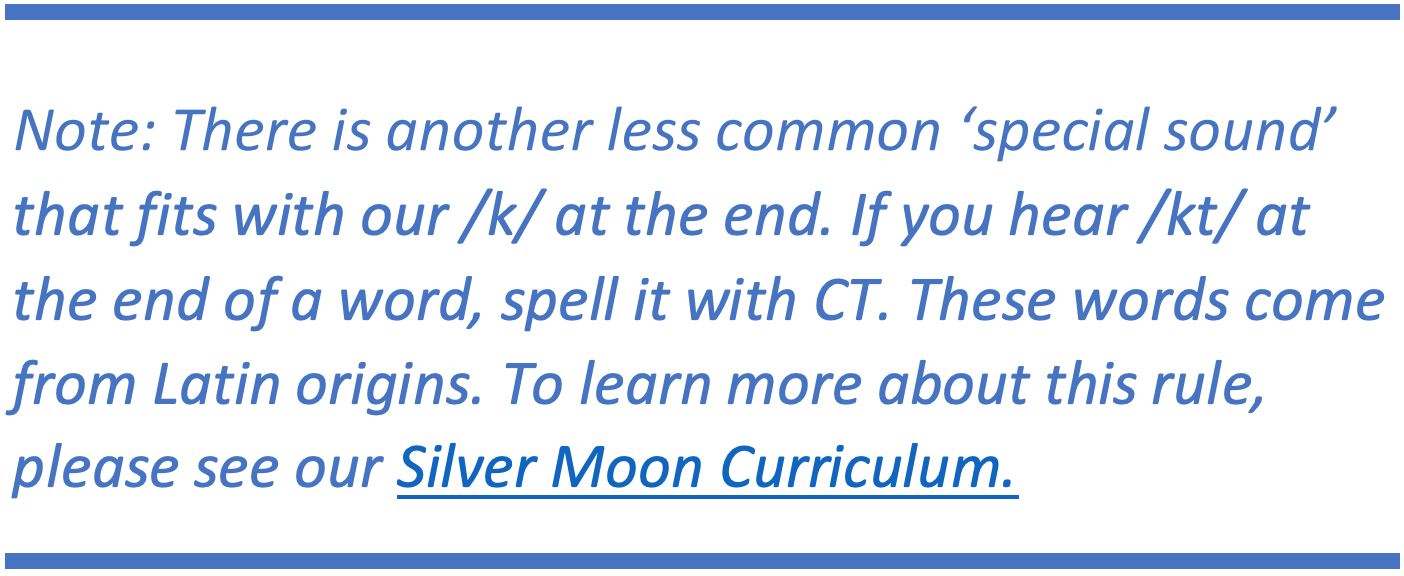Imagine yourself as a struggling speller… You know your letter-sound correspondences. You’ve worked hard to learn the differences between long and short vowel sounds, and you’ve worked through these funky things called digraphs (th, sh, ch, ck, wh). Now you’d like to simply sit down and write, but as you get started, you quickly realize that there are some words that you just can’t seem to spell. These are words you’ve heard hundreds of times. You’ve even seen these words before, but of course, you can’t picture what they look like in this moment. You see, the trouble is that the sound /k/ can be spelled in several different ways! Is it ‘K’? Is it ‘CK’? You remember that ‘C’ is used quite a bit too. If only someone could tell you exactly when to use each spelling!
 Photo by Les Anderson on Unsplash
Photo by Les Anderson on Unsplash
Is your heart pumping just a little bit faster as you think about this scenario? Then perhaps this imagery is more familiar to you than it is to other adults that you know. Here’s the exciting part: There IS a formula you can show your struggling spellers that will tell them exactly when to use each spelling. Thank goodness!
Before You Begin
Before we dive into the details, let’s look at some prerequisite skills that your student will need before our new rules are taught. If you’ve read my other blogs before, some of these skills will look familiar. Before teaching, make sure your student knows:
The ‘Good Stuff’
At this point, your student knows the above skills, so it’s time to dig into the spelling rule. To properly explain how to spell /k/ at the end, let me introduce you to our guest, the Elk...

Now, Mr. Elk may not look like he’s into this gig, but I assure you, he’s just not feeling himself. In fact, he’s quite under the weather.
Sick Elk
“At the end of a word, always spell /k/ with a CK after a short vowel—otherwise use K.”
Well, I suppose Mr. Elk’s tough day has helped us discover our first rule when spelling /k/ at the end! Let’s hash that out for a moment. First, it’s important to emphasize that there are two common ways to spell /k/ at the end of a word: CK and K. In order to know which to use, the speller must look at the letter right before the /k/ sound. Then, insert a CK if it’s a short vowel and K if it’s not. Easy peasy, lemon squeezy!
Unlike Kind Ken was Stinky and Cubs Can Drink Cola, this rule is a bit easier to navigate, as your student only has to look at the letter right before the target sound, following natural left-to-right writing order. I still tell students to begin practice by leaving a blank spot at the end and referring to their student spelling rule cards before deciding how to spell /k/.
Alright, let’s allow Mr. Elk to get some rest. Before we check out those great practice activities that we’ve grown to enjoy, I have one more guest to introduce you to!
Magic Trick
I’m going to withhold our next rule for just a moment to give you a bit of background information. While Sick Elk works most of the time to spell /k/ at the end of a word, it’s important to remember that there is a special sound that we need to pay attention to. At the end of a multisyllable word, we have to break our normal Sick Elk spelling pattern when we hear the sound /ick/. That’s right; it’s like that sound you make when you smell old leftovers—“ick!!” Some might call this a ‘rule breaker,’ but instead, I like to just call it a ‘special sound.’
“At the end of a multi-syllable word, /ick/ is spelled IC.”

And now we can all let out that pent up, ‘aww,’ as we appreciate just how cute our magician dog friend is! 
Important Tips To Consider...
More 'Good Stuff'
You may know what’s coming next, and if you do, thank you for following our Silver Moon blog. If you don’t, then let me be the first to welcome you! You are in for a treat. Below, you will find a collection of FREE practice activities and reproducibles for you to use as you teach this rule to your student. All you have to do is click, download, and print!
Sick Elk and Magic Trick Reproducibles
As always, if you found this blog helpful, please share it with your fellow teachers, parents, and interventionists. Interested in learning more? You can find our other spelling topics HERE, and don’t forget to check out our complete guide to spelling at www.Silvermoonspellingrules.com
Happy Teaching!
Written by:
Kate Wagner, BSE
Reading Interventionist, Remote Learning Coach